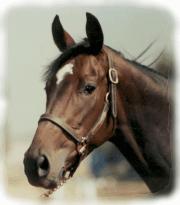
A Horse, of Course with Don Blazer |
If you enjoy learning about horses, then you'll love our online courses. Each month you'll find a new column on our web site. We hope you'll enjoy it, and maybe e-mail us with questions or suggestions for other columns. A Horse, Of Course is a monthly column syndicated by Success Is Easy. If you like the column, call your local newspaper, or local horse publication and ask them to subscribe by contacting Success Is Easy. |
Summer Heat Don Blazer copyright©2015 |

It was spring.
Now it’s summer. And it’s hot. It’s time for salt. It’s time for caution. It’s time to know the signs of fatigue, dehydration, exhaustion, heat stress and anhidrosis. All should alarm the astute horseman who knows how quickly these avoidable dangers can become killers. When a horse is not in condition, it doesn’t take much hot weather exercise to produce fatigue. The warning signs of fatigue are slow heart rate recovery, elevated heart rate for more than an hour, high respiratory rate – often shallow and inefficient. Take the horse’s temperature about every 30 minutes. If it is not dropping toward normal – 90 to 100 degrees Fahrenheit – you’ve got problems. Dehydration can be seen in lack of skin elasticity, prolonged capillary refill time, lack of intestinal sounds and pale, dry mucous membranes. Provide slow sips of cool water over a period of time until the horse refuses to drink. Dehydration should then be disappearing. Exhaustion and heat stress warning signs include depression, disinterest in his surroundings, muscle cramping or tremors, or muscle twitching and a lack of appetite or thirst. A lack of conditioning is usually a factor contributing to heat stress and exhaustion, so increase the horse’s work load slowly during the summer. To determine the danger of heat stress simply add the current temperature to the current percent of humidity. In Arizona, for example, a temperature of 104 added to a humidity percentage of 9 equals 113 and is well below the bench mark of 120, so the horse’s normal cooling mechanisms will be sufficient unless the horse is obese or still has a winter coat. If the temperature and humidity sum is higher than 140 the horse will rely on sweating to dissipate body heat. If the sum is greater than 150, the horse’s cooling system is going to be severely compromised. And if the sum is more than 180 the horse’s system isn’t going to be able to function, the internal temperature will continue to rise and the result will be severe heat stress. When suffering heat stress the horse loses fluids through sweating, steadily declining toward dehydration. The dehydration reduces blood flow to the skin and the body reacts by limiting the sweat to conserve body fluids. Heat continues to build with no relief and the horse declines into exhaustion. Such a horse will need fluid administered by a veterinarian. A horse suffering anhidrosis has lost the ability to sweat. When a horse doesn’t sweat, he can’t cool himself. The horse tries to pant, but doesn’t do a very good job at it, so his body temperature continues to rise and his performance declines. The cause of anhidrosis is not understood. A horse can be on a well-balanced diet with enough salt and electrolytes, drink enough water, and still not sweat. Anhidrotic horses will pant just as a salt-starved horse will, in an attempt to dissipate heat. For the anhidrotic horse, a product – One AC—has been quite successful. It does work better on some horses than others. For many anhidrotic horses the only solution is to be moved to a cooler climate. Salt-starved horses which do not sweat will begin to sweat again and return to normal several weeks after they have been supplemented with up to three ounces of loose salt per day. (Once a horse is sweating normally, two ounces of salt per day in hot weather should be sufficient at a normal work load.) Loose salt is better for horses than salt blocks since a horse’s tongue is smooth. It is hard for the horse to get enough salt from a block. When a horse is salt deprived, it is common for a horse to attempt to chew chunks from a salt block. Salt deficiency is associated with fatigue, dehydration, heat stress and exhaustion. So the next time you say, “Wow, it’s hot,” try to remember your horse is worth his salt. And see that he gets it! * Earn a degree in equine studies, or certification as a horse trainer, riding instructor or stable manager. Go to www.horsecoursesonline.com for more information. |